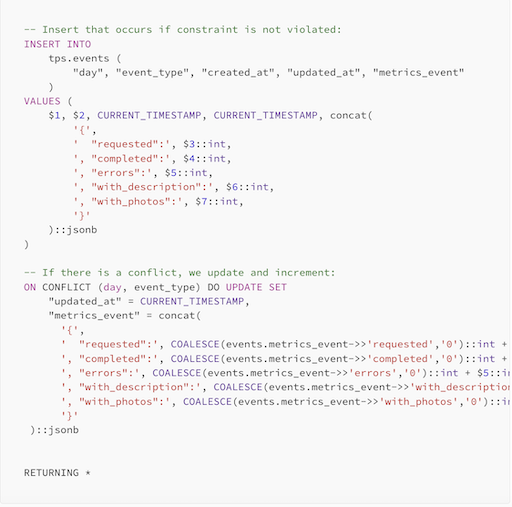PostgreSQL parameterized json inserts
PostgreSQL parameterized update/insert/upsert queries using jsonb columns, which are updated based on existing values

I also published this to Medium; my first article there!
The other day, I found myself writing a query for a client to store daily event aggregations with the details stored in a jsonb column. Rather than storing discrete events separately, the requirements were to aggregate multiple event metrics into a single row per day for each metric_type, so I chose to use a postgreSQL “UPSERT”. There isn’t an actual “UPSERT” statement in postgreSQL; it actually takes the form:
INSERT INTO table_name ...
ON CONFLICT(field_name) DO
UPDATE SET other_field_name=...
Basically, the UPSERT allows us to INSERT a record if none is present for that day and metric_type, and otherwise UPDATE the record with the new data. Here is the SQL/DDL for creating the table for this example:
CREATE TABLE IF NOT EXISTS tps.event_metrics
(
metric_type text COLLATE pg_catalog."default" NOT NULL,
created_at timestamp with time zone NOT NULL DEFAULT CURRENT_TIMESTAMP,
updated_at timestamp with time zone NOT NULL DEFAULT CURRENT_TIMESTAMP,
metrics jsonb,
day date
CONSTRAINT event_metrics_day_metric_type_unique UNIQUE (day, metric_type)
)
TABLESPACE pg_default;
ALTER TABLE IF EXISTS tps.event_metrics
OWNER to postgres;
CREATE INDEX IF NOT EXISTS event_metrics_metric_type_index
ON tps.event_metrics USING btree
(event_type COLLATE pg_catalog."default" ASC NULLS LAST)
TABLESPACE pg_default;
Note the CONSTRAINT clause that will cause a UNIQUE violation if an attempt is made to insert a row with the same day and metric_type. Essentially the metrics jsonb column is a dictionary with a name for a key and an associated count. I wasn’t exactly sure how to increment the values in the dictionary defined by the jsonb column, and even less how to do this with query parameters. I googled around and found some “solutions” that didn’t work for my situation, and eventually pieced something together that worked perfectly:
-- Insert that occurs if constraint is not violated:
INSERT INTO
tps.event_metrics (
"day", "metric_type", "created_at", "updated_at", "metrics"
)
VALUES (
$1, $2, CURRENT_TIMESTAMP, CURRENT_TIMESTAMP, concat(
'{',
' "requested":', $3::int,
', "completed":', $4::int,
', "errors":', $5::int,
', "with_description":', $6::int,
', "with_photos":', $7::int,
'}'
)::jsonb
)
-- If there is a conflict, we update and increment:
ON CONFLICT (day, event_type) DO UPDATE SET
"updated_at" = CURRENT_TIMESTAMP,
"metrics" = concat(
'{',
' "requested":', COALESCE(event_metrics.metrics->>'requested','0')::int + $3::int,
', "completed":', COALESCE(event_metrics.metrics->>'completed','0')::int + $4::int,
', "errors":', COALESCE(event_metrics.metrics->>'errors','0')::int + $5::int,
', "with_description":', COALESCE(event_metrics.metrics->>'with_description','0')::int + $6::int,
', "with_photos":', COALESCE(event_metrics.metrics->>'with_photos','0')::int + $7::int,
'}'
)::jsonb
RETURNING *
A few things to note:
- The jsonb “dictionary” is cobbled together using string concatenation. This can get messy, especially with so many entries, so I thought it should at least “look” like a dictionary.
- This is just a subset of what we might store in that column, and this example is modified from the real implementation, which is part of a closed-source project.
- Note the
::jsonbsuffix added to the built-up-dictionary. This was absent on many of the examples I found. I can attest that it is required (we are using version 14 ofpostgreSQL). - Also note the
::intsuffix used on the parameters, as well as the existing entries in thejsonbfield. COALESCEis used so we will always have a valid number to start from, even if these keys are missing from thejsonbfield.- The
UPDATE SETclause requires the field name be qualified with the table name (event_metrics.metrics), or a ambiguous reference error is encountered. - Finally, see the
->>operator used to access entries in thejsonbfield.
Summary
The json and jsonb columns provided by postgreSQL are powerful indeed. It may not be as obvious how to manipulate them when compared to first-order columns. This took me a few hours to figure out; hopefully it will be faster for you.
PostgreSQL provides more than a few functions to extract information and modify information for these fields. See documentation on json and jsonb functions here.
See the documentation on postgreSQL json/jsonb fields here.
